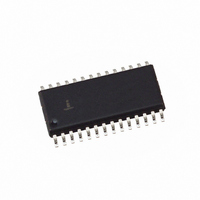HI5735KCB Intersil, HI5735KCB Datasheet - Page 9

HI5735KCB
Manufacturer Part Number
HI5735KCB
Description
IC DAC 12-BIT 80MSPS 28-SOIC
Manufacturer
Intersil
Datasheet
1.HI5735KCBZ.pdf
(11 pages)
Specifications of HI5735KCB
Settling Time
20ns
Number Of Bits
12
Data Interface
Parallel
Number Of Converters
1
Voltage Supply Source
Analog and Digital, Dual ±
Power Dissipation (max)
650mW
Operating Temperature
0°C ~ 70°C
Mounting Type
Surface Mount
Package / Case
28-SOIC (7.5mm Width)
Lead Free Status / RoHS Status
Contains lead / RoHS non-compliant
Available stocks
Company
Part Number
Manufacturer
Quantity
Price
Part Number:
HI5735KCB
Manufacturer:
INTERSIL
Quantity:
20 000
Company:
Part Number:
HI5735KCBZ
Manufacturer:
MAXIM
Quantity:
1 001
as glitch when changing the DAC output. Units are typically
specified in picoVolt-seconds (pV-s).
Applications
Bipolar Applications
To convert the output of the HI5735 to a bipolar 4V swing, the
following applications circuit is recommended. The reference
can only provide 125µA of drive, so it must be buffered to
create the bipolar offset current needed to generate the -2V
output with all bits “off”. The output current must be converted
to a voltage and then gained up and offset to produce the
proper swing. Care must be taken to compensate for the
voltage swing and error.
REF OUT
HI5735
I
OUT
(26)
(21)
a
FIGURE 14. BIPOLAR OUTPUT CONFIGURATION
(mV)
FIGURE 13. MEASURING GLITCH ENERGY
1/2 CA2904
HI5735
FIGURE 12. GLITCH TEST CIRCUIT
(21) I
+
-
OUT
t
(ns)
50Ω
5kΩ
64Ω
9
GLITCH ENERGY = (
0.1µF
LOW PASS
1/2 CA2904
100MHz
FILTER
+
-
5kΩ
SCOPE
60Ω
240Ω
240Ω
a
HFA1100
+
50Ω
-
x
t
)/2
V
OUT
HI5735
Definition of Specifications
Integral Linearity Error, INL, is the measure of the worst
case point that deviates from a best fit straight line of data
values along the transfer curve.
Differential Linearity Error, DNL, is the measure of the
error in step size between adjacent codes along the
converter’s transfer curve. Ideally, the step size is 1 LSB from
one code to the next, and the deviation from 1 LSB is known
as DNL. A DNL specification of greater than -1 LSB
guarantees monotonicity.
Feedthru, is the measure of the undesirable switching noise
coupled to the output.
Output Voltage Full Scale Settling Time, is the time
required from the 50% point on the clock input for a full scale
step to settle within an ±
Output Voltage Small Scale Settling Time, is the time
required from the 50% point on the clock input for a 100mV
step to settle within an
applications reconstructing highly correlated signals such as
sine waves with more than 5 points per cycle.
Glitch Area, GE, is the switching transient appearing on the
output during a code transition. It is measured as the area
under the curve and expressed as a picoVolt•Time
specification (typically pV•s).
Differential Gain, ∆A
wave with a normalized amplitude.
Differential Phase, ∆Φ, is the phase error from an ideal sine
wave.
Signal to Noise Ratio, SNR, is the ratio of a fundamental to
the noise floor of the analog output. The first 5 harmonics
are ignored, and an output filter of
used to eliminate alias products.
Total Harmonic Distortion, THD, is the ratio of the DAC
output fundamental to the RMS sum of the harmonics. The
first 5 harmonics are included, and an output filter of
clock frequency is used to eliminate alias products.
Spurious Free Dynamic Range, SFDR, is the amplitude
difference from a fundamental to the largest harmonically or
non-harmonically related spur. A sine wave is loaded into the
D/A and the output filtered at
eliminate noise from clocking alias terms.
Intermodulation Distortion, IMD, is the measure of the
sum and difference products produced when a two tone
input is driven into the D/A. The distortion products created
will arise at sum and difference frequencies of the two tones.
IMD can be calculated using the following equation:
IMD
=
20Log (RMS of Sum and Difference Distortion Products)
------------------------------------------------------------------------------------------------------------------------------------------------------ - .
(
RMS Amplitude of the Fundamental
V
, is the gain error from an ideal sine
1
/
1
2
/
2
LSB error band. This is used by
LSB error band.
1
/
2
the clock frequency to
1
/
2
the clock frequency is
)
1
/
2
the












